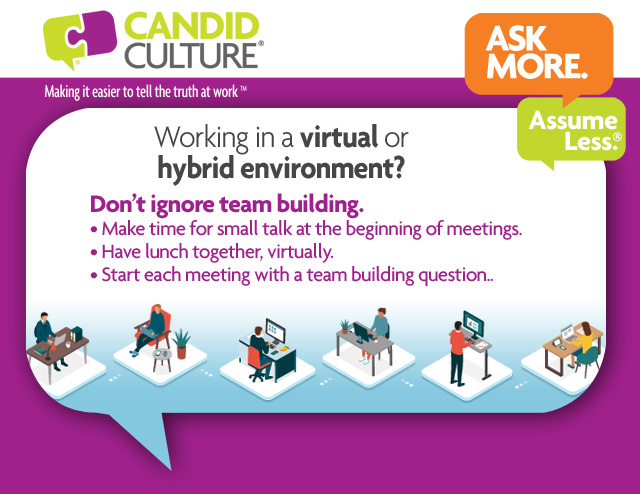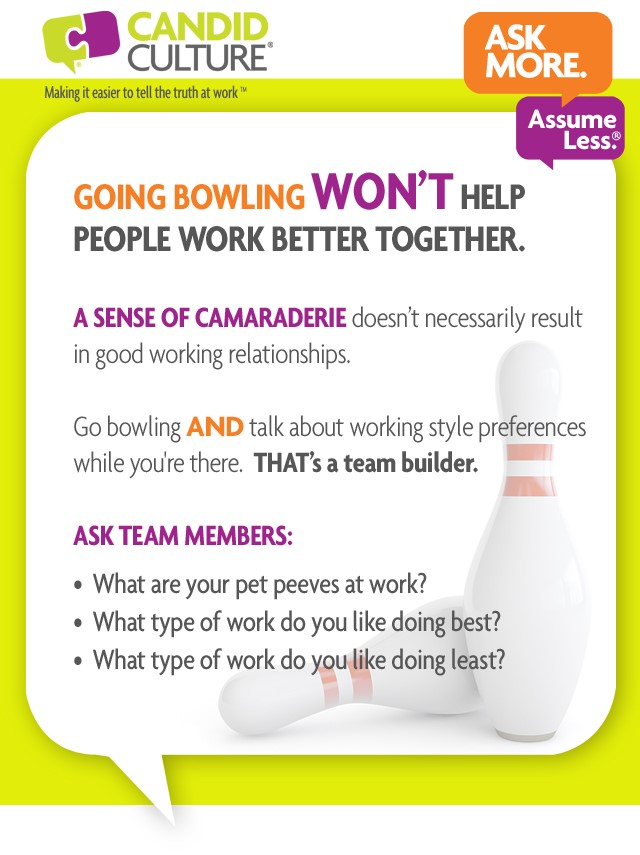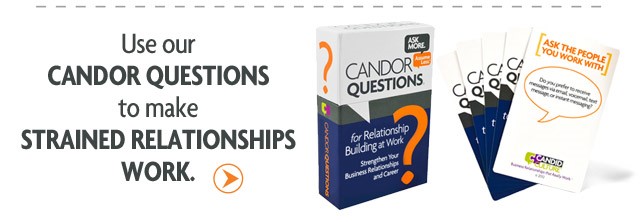Posts Tagged ‘team building at work’
One of the most frequent questions I get is how to retain an organization’s culture and build teamwork when people work virtually. It’s easy to forget about team building when you’re working hybrid or think that team building can’t be done virtually, or decide to wait to do team building until your whole team can get together in person. My advice; don’t wait.
Often the most meaningful aspects of work are the people we work with and the relationships we build. When you leave a job, you leave your laptop and take your friendships. You can build team work virtually; you just need to make the time.
Spend the first few minutes of virtual or hybrid meetings on small talk, just like you would if you were gathering in a physical conference room.
Eat lunch together, virtually. Remember when people used to sit together in the office breakroom or cafeteria? Why not eat together via video? Team building doesn’t have to be elaborate. It can just be spending time together.
Humans need people contact and relationships. Connections with our coworkers make us feel connected to our organizations.

Small talk and group lunches create camaraderie, but they don’t teach people how to work together. In addition to social activities, give people a chance to talk about working style preferences. You don’t have to do personality assessments and long training programs to build teamwork. Just give people a chance to talk about how they like to work, on a regular basis.
Tell your team you want to help people get to know each other better, so work gets done more easily. Start each team meeting with one of the questions below, then move on to your meeting agenda. Do this all year.
Here are a few team building questions you can use:
What are your pet peeves at work?
What time of day do you do your best work?
Do you leave your email, phone, or text alerts on at night? If I text you after hours, will you get a ping?
If I email you on weekends and evenings, do you think I expect a response? Would you prefer I send messages only during regular business hours?
What’s an area of our business you’d like to learn more about?
What’s something you’d like to learn to do that you don’t have a chance to do now?
Read a question to the group. Give everyone at the meeting the opportunity to answer the question about themselves. And remember, the meeting leader/facilitator speaks last. People will often follow the most senior person’s lead. You want people to answer authentically rather than providing what they think is the ‘right’ answer.
Team building doesn’t have to take a lot of time or money. Don’t wait until everyone is in the office or for a future retreat. Help coworkers spend time together formally and informally, getting to know each other better now.

Posted under
Team Building on June 4, 2023 by Shari Harley. Comments
Early in my career, I worked with a woman I didn’t get along with. We were on the same team and had the same job, but didn’t see eye to eye on how to approach work or solve problems. And when we didn’t agree, things got ugly. I have to admit to being afraid of her.
The odd thing is that socially, we did fine. When our team socialized outside of work, we had fun and got along well. That’s when I realized that there was no correlation between camaraderie and working well together.
Lots of teams go bowling, to baseball games, and out for happy hour as team building activities. And while team members may enjoy being together at these events and get to know each other personally, they don’t learn how to work well together and how to resolve conflict.

Go bowling or out for happy hour, just don’t expect people to work better together as a result of those activities. If you want to do impactful team building activities, give team members a chance to learn about each other and themselves, and make agreements of how team members will work together in the future. Create occasions for candid conversations.
When I lead corporate team building activities, I put people in small groups, give the group a box of Candor Questions for Team Building and time to answer the questions. People talk about things they should have talked about when they started working together. Team members learn about each other’s working style preferences and what each person needs from both the job and each other. But most importantly, team members have permission to talk about things they normally don’t, and begin to create a climate of candor, which is essential for any group of people working together. For a team to work well together, it must be safe to tell the truth. Teams need to talk about the things that impact them most – each other.
So go bowling and out for happy hour. But also create opportunities for team members to talk about the things that matter most — how they impact each other at work.
 te
te
Chances are, at some point in your career, you’ve worked with someone you wished would go away. Maybe the person repeatedly threw you under the bus, took credit for your work, or didn’t keep their commitments. And at some point, you wrote the person off, and have been merely tolerating them ever since.
Damaged relationships can be repaired, if you’re willing to do some work.
The first step in repairing a damaged relationship is to decide that you really want to do so. Managing conflict in the workplace isn’t easy. It will take effort and will likely be uncomfortable, so before you take action, decide if you really want to work on the relationship.

How to know if you should try resolving conflict in the workplace: Ask yourself how much you need the relationship. This probably sounds political, and it is. If you work on projects together, need to give or receive information, or have to work together regularly, then it’s likely worth working on the relationship. If you don’t need to work together regularly, then perhaps don’t work on the relationship.
If you decide to attempt to strengthen a relationship, plan what you’re going to say. Never trust the first thing that comes out of your mouth during a difficult conversation.
Step one for resolving conflict in the workplace: Like any feedback conversation, start with the end in mind. Consider what you want to have happen as a result of the conversation.
Step two for resolving conflict in the workplace: Plan what you’re going to say by taking notes and practicing out loud. What you say in your head is usually not what comes out of your mouth.
Step three for resolving conflict in the workplace: Ask the person for time on their calendar. People don’t like surprises. You’ll have a better outcome if the person has blocked time to talk with you. Have the conversation in-person whenever possible. If you can’t speak in-person, talk on the phone. Do not attempt to fix your relationship via email. 1. Email is wimpy. 2. It will not work.
Tell the person, “Our relationship is strained. I don’t think I’m saying anything we’re not both aware of. I’d really like a good working relationship. Would you be willing to have coffee or lunch with me, and we can talk about what has happened and perhaps start in a new way?”
Step four for resolving conflict in the workplace: Ask for a meeting to work on the relationship up to three times. If, after the third time, the person hasn’t made time, stop asking. You can’t work with someone who won’t work with you. If the person doesn’t make time to meet, be polite, professional, and inclusive, but stop trying to nurture the relationship. Inclusive means: cc’ing them on necessary emails, inviting them to appropriate meetings, and providing necessary data.
Step five for resolving conflict in the workplace: If the person makes time to meet, speak candidly, be yourself, and be vulnerable. I don’t mean be a doormat. I do mean be authentic.
How to Manage Difficult Conversations:
- Tell the person what you want.
- Ask for feedback about how you’ve damaged the relationship.
- Listen to what you hear, and resist the urge to defend yourself.
- Ask for permission to tell him how he’s damaged the relationship.
- Give small amounts of feedback, with a few specific examples.
- Make agreements of what each of you will do differently in the future.
- Thank the person for the conversation and schedule another meeting.
Step six for resolving conflict in the workplace: Build in follow-up. Most people have one conversation and expect things to be fixed forever. Relationships don’t work that way. Agree to meet monthly, for the first few months, until you’ve rebuilt trust and learned how to communicate and work together. During the monthly meetings, give each other permission to give candid feedback about how you’re working together. I call these Relationship Inventory Meetings.
During monthly Relationship Inventory Meetings ask:
- What’s working about how we work together?
- What’s not working?
- What working agreements did we keep?
- What working agreements did we break?
- Which working agreements are helpful?
- What working agreements need to change?
You might be thinking, “I don’t like this person. I don’t want to work with them. And I definitely don’t want to have these uncomfortable conversations.”
- If the nature of your relationship is impacting your ability to do your job, your professional reputation, or your happiness, all of those consequences are far worse and more long-lasting than any conversation will be.
- The conversations won’t be as bad as you think. No one will tell you anything you can’t handle, because for the most part, they’re afraid of your reaction and they know they’ll be next.
Conflict in the workplace and damaged relationships keep people up at night, reduce job satisfaction, and often motivate people to leave jobs. If you’re experiencing any of these things, all of them are worse than any conversation will be. The anticipation of the conversation is far worse than the conversation itself.
- Decide if you want to strengthen the relationship.
- Plan the conversation.
- Ask for time to meet.
- Have the conversation. Speak honestly, but responsibly.
- Plan to have another conversation before ending this conversation.
- Congratulate yourself for being courageous and picking happiness over anxiety and frustration.






 te
te

